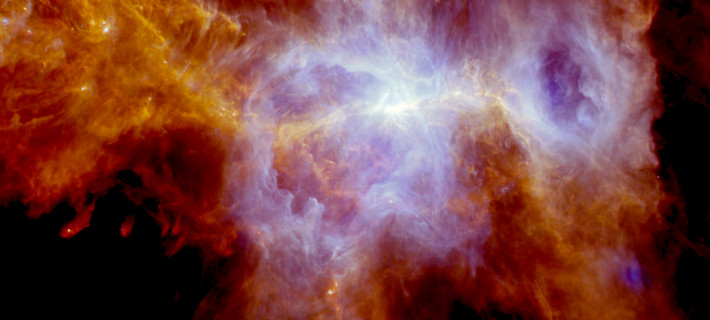| Basic Information | |
| What is this? | A star forming region in Orion |
| Where is it in the sky? | In the constellation of Orion |
| How big is it? | The clump is around 10,000 larger than the Earth’s orbit around the Sun, making it about 100 time larger than the Sun’s planetary system |
| How far away is it? | The Orion Nebula is about 1500 light years away |
| What do the colours represent? | Bluer regions are warmer, heated by young stars or by compression from jets. Red and orange regions are cooler. |
Downloads
See this object in:
Results from Herschel may have helped to solve a puzzle surrounding our own Sun’s past. By studying very young stars in the Orion Nebula, astronomers have been able to gain an insight into how the Sun may have been behaving in its youth.
By using the HIFI spectrometer to detect the far-infrared light at very specific frequencies, the team obtained the chemical fingerprint of a range of atoms and molecules within the clump of gas and dust in which the stars are forming. This also allows a study of the temperature, and showed that the gas and dust are relatively warm, though still at around -200 Celsius. It is thought that the Sun formed in a similar environment, and so studies of such regions allow astronomers to examine one possible history of the Sun’s life.
The mystery about our own Sun relates to evidence for a particular form, or isotope, of the element beryllium in meteorites found on Earth. This particular isotope, called beryllium-10, is relatively unusual in that it is not formed in the fusion reactions within stars, or in the supernova explosions which occur when massive stars die. Rather, it is formed when very energetic particles slam into heavier, and more common, elements such as oxygen.
Beryllium-10 doesn’t normally hang around, though, because it decays into a specific set of lighter elements. The fact that breyllium-10 is present means that it was being created as the rocks formed, which suggests the that material in the early Solar System was being bombarded by very energetic particles. The big question has been whether these particles were produced by the young Sun, or whether they originated further afield in the deaths of massive stars.
One way of gaining a handle on that question is to study stars at a similar stage of their life – hence the interest in the young stars in Orion. An interesting result from the latest study was the relative amounts of molecules containing hydrogen combined with other atoms such as carbon, oxygen and nitrogen. In most star-forming environments the nitrogen-bearing molecules such as diazenylium (N2H+) are destroyed relatively easily, leaving an over-abundance of molecules such as hydrogen carbonate (HCO).
However, in the case of this particular clump, known as “OMC-2 FIR4”, it appears that the HCO has been destroyed almost as quickly as the N2H+. The only explanation for the destruction of both types of molecule is a surprisingly high rate of energetic particles – and at a rate easily high enough to explain the presence of beryllium-10 in the meteorites. While it doesn’t rule out other possibilities, it is strong evidence that the Sun may have been much more active in its youth.
Detailed Information
Ceccarelli et al. (2014) ApJ 790 L1, “Herschel finds evidence for stellar wind particles in a protostellar envelope: is this what happened to the young Sun?
- Young Sun’s violent history solves meteorite mystery (ESA website)
- Embracing Orion (ESA website)


Comments are closed.